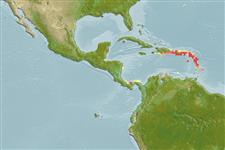>
Blenniiformes (Blennies) >
Chaenopsidae (Pike-, tube- and flagblennies)
Etymology: Emblemariopsis: Latin, emblema = insertion, inlaid work, raised ornament + Greek, opsis = appearance (Ref. 45335); carib: Named for the Carib native people of the Antilles; noun in apposition..
Environment: milieu / climate zone / depth range / distribution range
Οικολογία
Θαλασσινό(ά) Υφαλόφιλο(α); εύρος βάθους 5 - 15 m. Tropical
Western Central Atlantic: Hispaniola and the nothern Lesser Antilles.
Μέγεθος / Βάρος / Age
Maturity: Lm ? range ? - ? cm
Max length : 1.5 cm SL αρσενικό/απροσδιόριστο; (Ref. 85868)
Short description
Κλείδες προσδιορισμού | Μορφολογία | Μορφομετρία
Ραχιαίες άκανθες (συνολικά) : 19 - 21; Μαλακές ραχιαίες ακτίνες (συνολικά) : 10 - 12; Εδρικές άκανθες: 2; Μαλακές εδρικές ακτίνες: 19 - 21. This species is diagnosed by the following characters: TP territorial males found in holes with a black head and blackened anterior dorsal fin with a distal red band over a narrow white band and a thin white margin; first spine very long, when adpressed reaching to 8th-15th, equal or more than HL up ti 27% SL, second spine usually about 1/2-2/3 of first, third spine about 1/3-1/2 of first, the tenth spine at most 1/2 of first, anterior dorsal fin profile with a deep concavity since third and fourth spines are well shorter than subsequent spines (Ref. 125603).
Dark-shaded and pale TP with a similarly long first dorsal-fin spine and red band, sometimes several single scattered dark spots on the anterior spinous-dorsal-fin membranes, but not in a row; absence of opercular bands or lines, and of dark spots along lateral midline or above lateral midline (Ref. 125603).
IP has an elongated first two dorsal-fin spines, the first reaching to base of 6th-8th spine base when adpressed, the second slightly shorter, and the third half of first (earlier IP and juvenile with less elongate spines). Colouration: live colors include red, orange, and pink; cranial pattern with bands that are progressively breaking up and additional spots filling in: band 1 usually with two red spots; band 2 indistinct, with a few red spots and not a Y-shape; band 3 is most prominent, with thick red arms of a U breaking up into spots; band 4 thin and pale and pushed aside by red spots; band 5 with thick red segments; later pattern with red spots expanded to form a mosaic; IP head spots are dark and usually full complement; melanophores are near pectoral-fin base usually one to three spots, anterior spot often elongated obliquely (Ref. 125603).
Dark males photographed in holes in both live and dead corals, of several species and of different morphologies, including holes embedded among encrusting sponges. The IP individuals are mostly photographed on live coral substrate (Ref. 125603). Depth range given by B. Victor (pers. comm. 10/18).
Life cycle and mating behavior
Maturities | Αναπαραγωγή | Spawnings | Egg(s) | Fecundities | Προνύμφες
Victor, B.C., 2020. Review of the glass blennies (Teleostei: Chaenopsidae: Emblemariopsis) with two new species from the Caribbean Sea. J. Ocean Sci. Foundation 37:1-122. (Ref. 125603)
IUCN Red List Status (Ref. 130435)
Threat to humans
Harmless
Human uses
Εργαλεία
Special reports
Download XML
Διαδικτυακές πηγές
Estimates based on models
Phylogenetic diversity index (Ref.
82804): PD
50 = 0.5001 [Uniqueness, from 0.5 = low to 2.0 = high].
Bayesian length-weight: a=0.00457 (0.00183 - 0.01143), b=3.08 (2.86 - 3.30), in cm total length, based on LWR estimates for this (Sub)family-body shape (Ref.
93245).
Τροφικό Επίπεδο (Ref.
69278): 3.0 ±0.4 se; based on size and trophs of closest relatives
Fishing Vulnerability (Ref.
59153): Low vulnerability (10 of 100).
